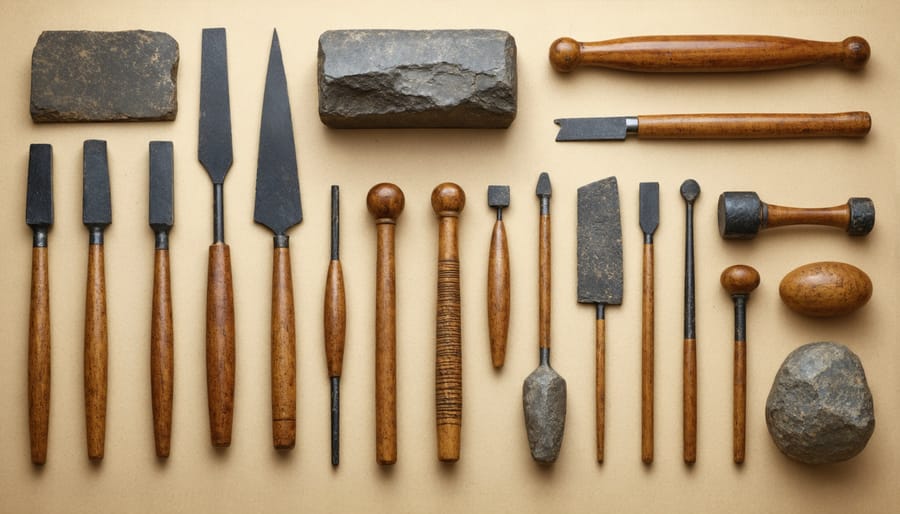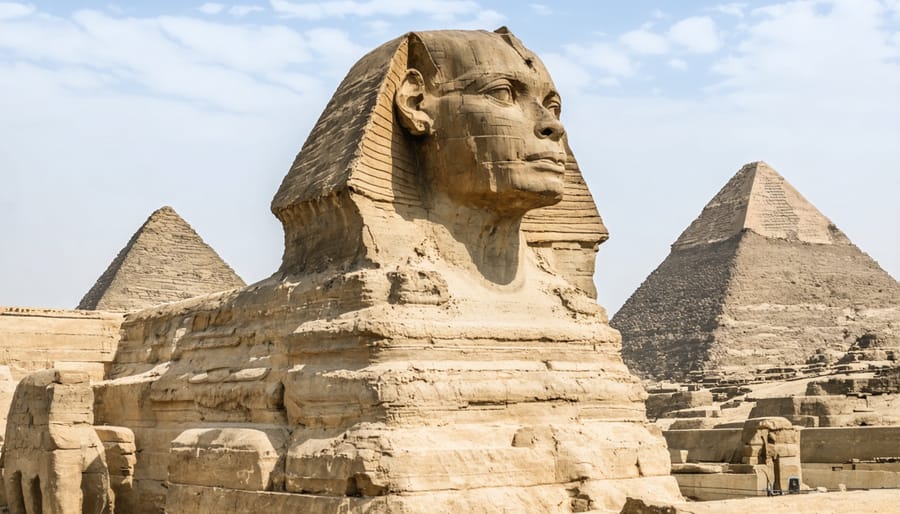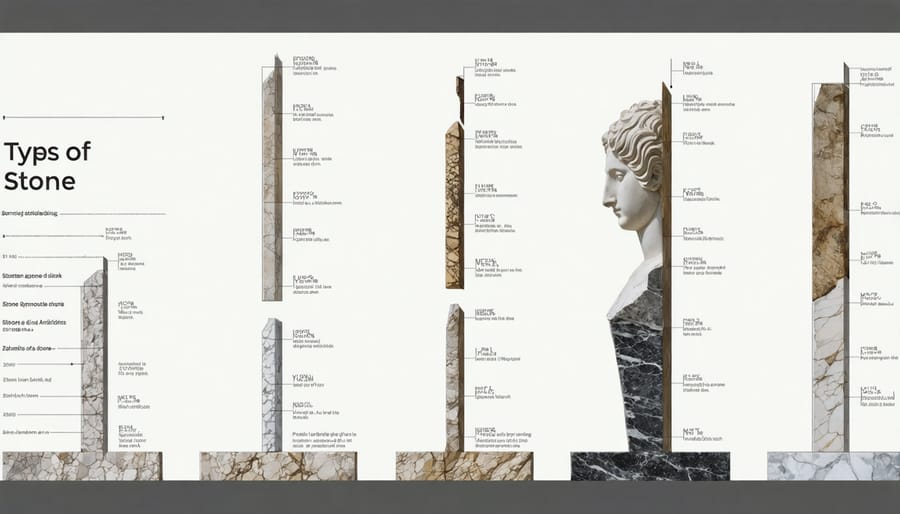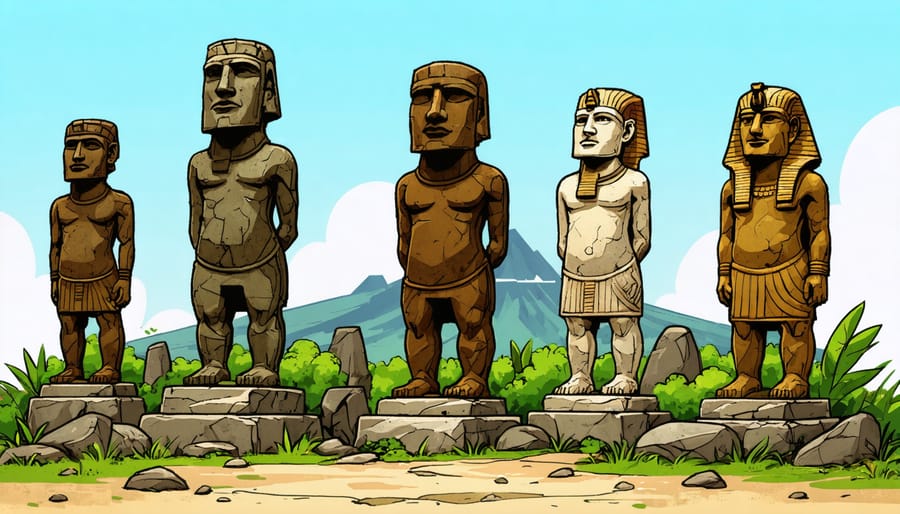Throughout millennia, ancient stone statues have stood as enduring testaments to humanity’s artistic mastery and spiritual devotion. From the towering moai of Easter Island to the delicate marble sculptures of classical Greece, these stone sentinels capture the essence of cultural expression through stone sculpture across civilizations. Master craftsmen transformed raw stone into powerful symbols of divine authority, cultural identity, and human achievement, using techniques so sophisticated that modern artisans still study them today.
Ancient stone statuary represents far more than mere decorative art—it embodies the technological capabilities, religious beliefs, and social structures of vanished societies. These masterworks reveal how early civilizations solved complex engineering challenges, developed sophisticated tools, and created lasting monuments that continue to influence contemporary architecture and design. Whether carved from limestone, granite, or marble, each statue tells a story of innovation, artistic vision, and the universal human desire to leave an indelible mark on history.
As we uncover more archaeological evidence, these silent witnesses to history continue to provide invaluable insights into ancient craftsmanship, cultural practices, and artistic evolution. Their preservation and study remain crucial to understanding humanity’s creative journey and technological advancement through the ages.
The Evolution of Stone Carving Techniques
Early Tools and Methods
The earliest stone sculptors employed remarkably simple yet effective tools to create their masterpieces. Through examining ancient stone carving traditions, archaeologists have discovered that basic hammerstones were among the first implements used to shape rock. These naturally rounded stones served as primitive percussion tools, allowing artisans to chip away at larger blocks to create rough forms.
As techniques evolved, craftsmen began using harder stone tools specifically shaped for different carving purposes. Stone picks and chisels, often made from flint or obsidian, enabled more precise detailing. Copper tools emerged during the Bronze Age, marking a significant advancement in sculpting capability. These softer metal implements, when combined with abrasive sand, proved highly effective for detailed work.
The ancient sculptors also developed sophisticated methods for extracting and moving stone blocks. They learned to identify natural fissures in rock formations and used wooden wedges, which, when soaked with water, would expand and split the stone along these lines. This technique, known as cleaving, allowed for more controlled extraction of workable pieces while minimizing waste and damage to the material.

Advanced Carving Innovations
Ancient civilizations continuously refined their stone carving techniques, developing sophisticated methods that revolutionized statue creation. The Egyptians pioneered the use of copper chisels and stone hammers, introducing a systematic approach to carving that began with gridded guidelines marked in red ochre on stone blocks. This method ensured unprecedented precision in their monumental works.
Greek sculptors later advanced these techniques by introducing the pointing method, using a framework of reference points to transfer precise measurements from clay models to stone. This innovation allowed for more complex poses and detailed anatomical accuracy in their statues.
In Asia, Chinese artisans developed unique abrasive techniques using quartz sand and water to achieve incredibly smooth finishes on jade and other hard stones. Indian sculptors mastered the art of cave temple carving, working from top to bottom to create entire architectural complexes from solid rock.
The Romans contributed significantly by perfecting the use of different-sized chisels and developing specialized tools for specific textures. They also introduced mechanical lifting devices and sophisticated scaffolding systems that enabled the creation of colossal statues.
These innovations laid the foundation for modern stone sculpting techniques, many of which are still employed by contemporary artists.
Notable Ancient Stone Statues Across Cultures
Egyptian Stone Mastery
Ancient Egyptian stone sculptors achieved remarkable precision and artistry in their craft, developing techniques that continue to astound modern experts. Their mastery of hard stones like granite, basalt, and diorite demonstrates an advanced understanding of material properties and tools. The craftsmen employed copper chisels, stone hammers, and abrasive sand to shape and smooth these challenging materials.
Egyptian statuary followed strict canonical proportions, using a grid system to maintain consistency across different scales. Sculptors began by marking guidelines on stone blocks, then roughly carved the basic form before proceeding with detailed work. This methodical approach ensured accuracy and maintained religious and cultural symbolism integral to Egyptian art.
The finishing process involved progressive stages of smoothing using increasingly finer abrasives. Quartzite sand and stone rubbers were used for initial smoothing, followed by finer materials like sandstone and finally powdered quartz for polishing. This meticulous attention to surface treatment created the characteristic lustrous finish seen on many Egyptian statues.
Notable examples include the Great Sphinx, carved from a single limestone outcrop, and the colossal statues of Ramesses II at Abu Simbel. These monuments showcase not only technical expertise but also the Egyptians’ ability to handle massive stone blocks while maintaining precise detail and proportion. Their techniques influenced stone craftsmanship throughout the ancient world and continue to inform modern stone working practices.

Greek and Roman Contributions
The Classical period marked a revolutionary era in stone sculpture, with Greek and Roman artisans achieving unprecedented levels of anatomical accuracy and emotional expression. Greek sculptors of the 5th and 4th centuries BCE pioneered techniques for capturing the human form in marble with astounding realism, as exemplified by the works of masters like Phidias and Praxiteles.
The Greeks developed the contrapposto stance, where figures stand with weight shifted to one leg, creating a natural, dynamic pose that transformed static stone into seemingly living forms. This innovation, along with their mastery of drapery carving, allowed sculptors to suggest movement and underlying anatomy even through carved clothing.
Roman artists built upon Greek foundations, adding their own innovations in portraiture and relief sculpture. They excelled at capturing individual likenesses in stone, creating detailed portrait busts that served both artistic and documentary purposes. Romans also pioneered efficient copying techniques, helping preserve Greek masterworks through marble replicas.
Both civilizations preferred fine-grained marble, particularly from quarries on the Greek island of Paros and Italy’s Carrara region. Their sculptors developed sophisticated tools and finishing techniques, including the use of rasps for smooth surfaces and drills for deep folds in drapery. Many of these methods continue to influence contemporary stone carving practices, demonstrating the enduring legacy of Classical sculpture.
Asian Stone Artistry
Eastern stone sculpture traditions represent some of the most sophisticated and enduring artistic achievements in human history. From the intricately carved Buddhist temples of Angkor Wat to the serene Buddha statues of ancient China, Asian artisans developed unique techniques that continue to influence modern stone craftsmanship.
Chinese stone carving traditions, dating back to the Shang Dynasty (1600-1046 BCE), emphasized the natural qualities of the stone material. Artists often worked with jade and marble, creating sculptures that balanced detailed craftsmanship with spiritual symbolism. The famous terracotta warriors of Xi’an exemplify the mastery of mass production while maintaining individual artistic detail.
In India, stone sculptors created elaborate temple complexes like those at Khajuraho and Ellora, demonstrating exceptional skill in transforming solid rock into delicate, flowing forms. These artisans developed specialized tools and techniques for working with different types of stone, from soft soapstone to harder granite.
Japanese stone art traditionally focused on garden sculpture and religious monuments, with stone lanterns and Buddha statues being prominent examples. Their approach often emphasized minimalism and the natural beauty of unworked stone surfaces, creating a harmony between carved and untouched elements.
Korean stone artists were particularly renowned for their Buddha statues and pagodas, developing distinctive styles that combined Chinese influences with local artistic traditions. The precision of their carving techniques, especially in granite work, remains impressive by modern standards.
Stone Selection and Properties

Preferred Stone Types
Ancient civilizations carefully selected specific stone types for their statuary based on durability, workability, and aesthetic appeal. Marble emerged as a premier choice across many cultures, particularly in Classical Mediterranean civilizations, due to its fine grain, translucent quality, and ability to capture subtle details. The white marble of Carrara, Italy, became especially prized for its pure color and consistent texture.
Limestone proved popular in Egyptian and Middle Eastern sculpture for its relative softness when freshly quarried and its ability to harden over time through exposure to air. This characteristic made it ideal for detailed carving while ensuring longevity. Granite, though more challenging to work with, was favored for monumental pieces and outdoor installations due to its exceptional durability and resistance to weathering.
Basalt and diorite, dense igneous rocks, were particularly valued in ancient Egypt and Mesopotamia for creating dark, imposing figures that symbolized power and permanence. Sandstone, while softer and more prone to erosion, was widely used in regions where harder stones were less available, offering sculptors a more forgiving medium for detailed work.
Weathering and Preservation
Ancient stone statues have endured centuries of exposure to various environmental conditions, with their survival largely dependent on the type of stone used and environmental factors. Harder stones like granite and basalt typically show remarkable resilience, while softer materials like limestone and sandstone often exhibit more significant weathering patterns. The impact of climate plays a crucial role, with statues in arid regions generally preserving better than those in humid environments.
Modern analysis has revealed how different stone preservation techniques were employed by ancient craftsmen to protect their works. Some civilizations applied protective coatings or placed statues in sheltered locations to minimize degradation. Archaeological evidence suggests that regular maintenance practices, including cleaning and surface treatments, were common in many ancient cultures.
Today, these historical weathering patterns provide valuable insights for contemporary conservation efforts. Conservators study the natural aging processes of different stone types to develop more effective preservation strategies, ensuring these cultural treasures survive for future generations to appreciate and study.
Modern Lessons from Ancient Stone Art
Traditional Methods in Modern Use
Contemporary stone sculptors continue to embrace ancient techniques, recognizing their enduring effectiveness and authenticity. The basic process of roughing out forms with a hammer and chisel remains largely unchanged since antiquity, though modern tools now complement these traditional methods. Many artists still prefer hand-carving for detailed work, using techniques that can be traced back to Egyptian and Greek masters.
The ancient practice of pointing, where measurements are transferred from a model to stone using reference points, remains essential in modern sculpture. Artists also maintain the graduated approach to finishing, progressing from coarse to fine tools, just as their predecessors did thousands of years ago.
Traditional surface treatment methods, such as polishing with abrasive stones and adding texture with various chisels, continue to produce the desired aesthetic effects. Modern sculptors often combine these time-tested techniques with contemporary power tools, achieving efficiency while maintaining artistic integrity.
The apprenticeship model, fundamental to ancient stone carving traditions, persists in many modern studios, where experienced artisans pass down their knowledge to the next generation. This preservation of ancient methods ensures the continuation of authentic stone sculpting practices while allowing for innovation within the craft.
Preservation Techniques
The preservation of ancient stone statues requires a delicate balance of traditional techniques and innovative technologies. Today’s conservators employ a range of modern preservation methods to protect these irreplaceable artifacts from environmental damage and natural deterioration.
Primary conservation strategies include careful cleaning using specialized materials, consolidation treatments to strengthen weakened stone, and protective coatings that shield against moisture and pollutants. Laser cleaning has emerged as a precision tool for removing surface contaminants without damaging the underlying stone structure.
Environmental control plays a crucial role in preservation. Museums and conservation facilities maintain strict temperature and humidity levels to prevent mineral crystallization and biological growth. Regular monitoring using advanced imaging techniques helps detect early signs of deterioration, allowing conservators to intervene before significant damage occurs.
Digital documentation through 3D scanning and photogrammetry creates detailed records of statues’ current conditions, enabling precise tracking of changes over time. These digital archives also serve as valuable resources for potential future restoration work and academic study, ensuring that even if physical damage occurs, the artwork’s form and details are preserved for future generations.
Ancient stone statuary stands as a testament to humanity’s enduring artistic vision and technical mastery across millennia. From the towering moai of Easter Island to the refined sculptures of Classical Greece, these stone monuments continue to captivate and inspire audiences worldwide. Their influence extends far beyond their original cultural contexts, shaping modern architectural design, contemporary sculpture, and our understanding of human creativity.
The preservation of these ancient works provides invaluable insights into historical sculpting techniques, tools, and materials that remain relevant to modern stone artisans. Many contemporary sculptors still employ methods that have changed little since antiquity, demonstrating the timeless nature of stone craftsmanship. The durability of stone as a medium has allowed these ancient masterpieces to survive as bridges between past civilizations and present-day observers.
Today, ancient stone statuary influences everything from public art installations to architectural ornamentation. Museums worldwide continue to study and preserve these artifacts, using advanced technology to unlock new details about their creation and cultural significance. Digital scanning and reproduction techniques have made these works more accessible than ever, allowing for detailed study and appreciation by audiences globally.
The legacy of ancient stone statuary reminds us that despite technological advances, the fundamental human desire to create lasting beauty in stone remains unchanged. These enduring works continue to inspire new generations of artists and craftspeople, ensuring that the tradition of stone sculpture remains vibrant and evolving in the modern world.










